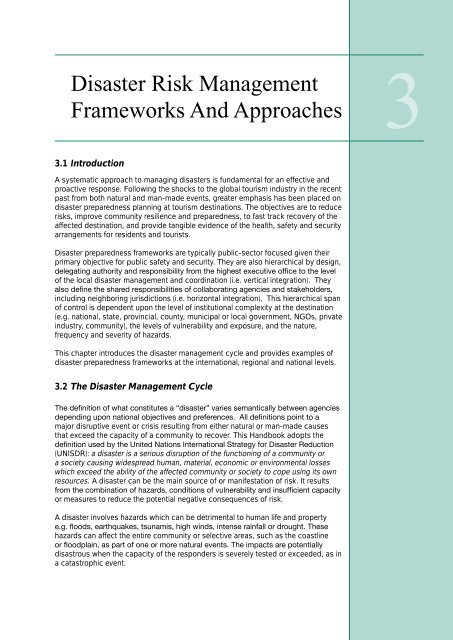Disaster Risk Management For Coastal Tourism Destinations - DTIE
Disaster Risk Management For Coastal Tourism Destinations - DTIE
Disaster Risk Management For Coastal Tourism Destinations - DTIE
Create successful ePaper yourself
Turn your PDF publications into a flip-book with our unique Google optimized e-Paper software.
3<br />
<strong>Disaster</strong> <strong>Risk</strong> <strong>Management</strong><br />
Frameworks And Approaches<br />
3<br />
3.1<br />
Introduction<br />
A systematic approach to managing disasters is fundamental for an effective and<br />
proactive response. Following the shocks to the global tourism industry in the recent<br />
past from both natural and man-made events, greater emphasis has been placed on<br />
disaster preparedness planning at tourism destinations. The objectives are to reduce<br />
risks, improve community resilience and preparedness, to fast track recovery of the<br />
affected destination, and provide tangible evidence of the health, safety and security<br />
arrangements for residents and tourists.<br />
<strong>Disaster</strong> preparedness frameworks are typically public-sector focused given their<br />
primary objective for public safety and security. They are also hierarchical by design,<br />
<br />
of the local disaster management and coordination (i.e. vertical integration). They<br />
<br />
including neighboring jurisdictions (i.e. horizontal integration). This hierarchical span<br />
of control is dependent upon the level of institutional complexity at the destination<br />
(e.g. national, state, provincial, county, municipal or local government, NGOs, private<br />
industry, community), the levels of vulnerability and exposure, and the nature,<br />
frequency and severity of hazards.<br />
This chapter introduces the disaster management cycle and provides examples of<br />
disaster preparedness frameworks at the international, regional and national levels.<br />
3.2<br />
The <strong>Disaster</strong> <strong>Management</strong> Cycle<br />
<br />
<br />
major disruptive event or crisis resulting from either natural or man-made causes<br />
that exceed the capacity of a community to recover. This Handbook adopts the<br />
<br />
(UNISDR): a disaster is a serious disruption of the functioning of a community or<br />
a society causing widespread human, material, economic or environmental losses<br />
which exceed the ability of the affected community or society to cope using its own<br />
resources. A disaster can be the main source of or manifestation of risk. It results<br />
<br />
or measures to reduce the potential negative consequences of risk.<br />
A disaster involves hazards which can be detrimental to human life and property<br />
<br />
hazards can affect the entire community or selective areas, such as the coastline<br />
<br />
disastrous when the capacity of the responders is severely tested or exceeded, as in<br />
a catastrophic event.<br />
29

















